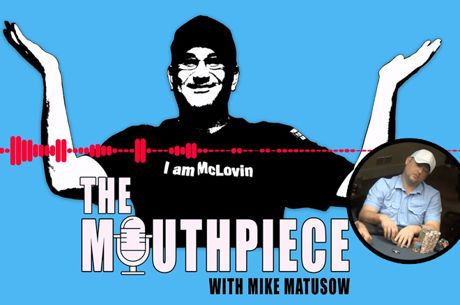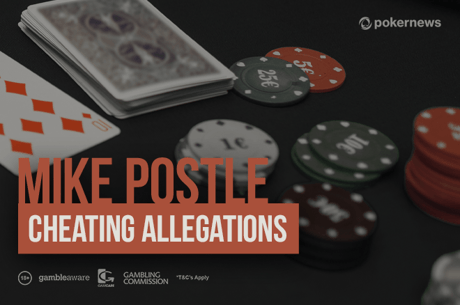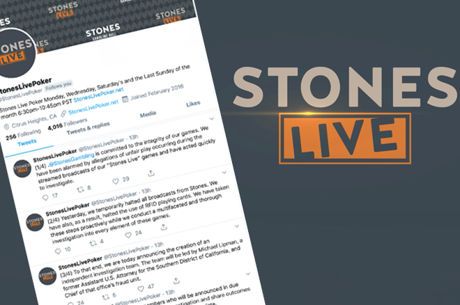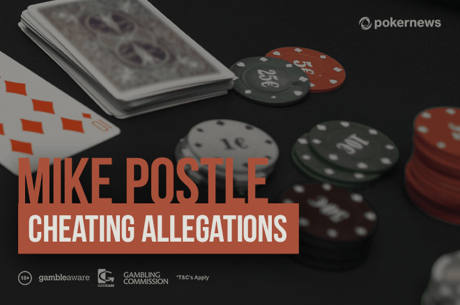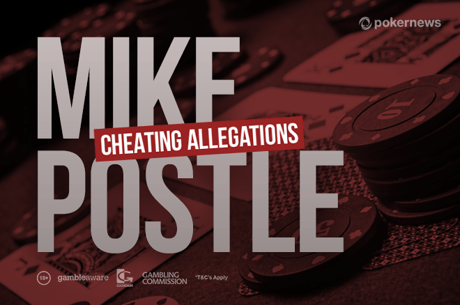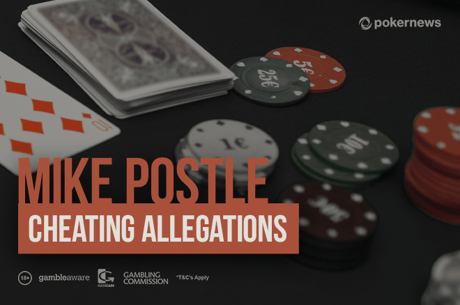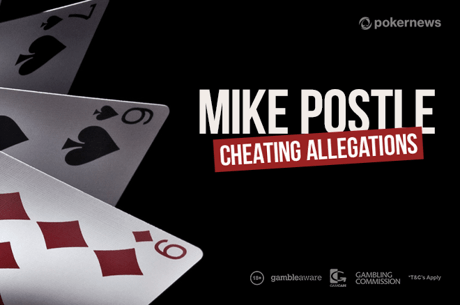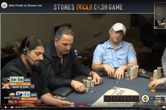Graphics Company Reacts to Mike Postle Cheating Allegations Saga
Table Of Contents
Editor's note: This article has been updated with additional comments from Andrew Milner regarding the conditions that need to be set to give access to the live data view (Oct. 7, 2019, 5:38 PM CEST/11:38 AM EST).
"As the developer of PokerGFX, I spend a lot of time thinking about game integrity and ways to secure my hardware and software against malicious use, so the information that has been revealed in the past week has been interesting, to say the least."
If you organize poker tournaments, have an interesting home game, or regularly run cash games, and you want the world to watch what's going on, you have several options. This ranges from a full production set-up including a dedicated team of outside professionals to take care of everything, or you can organize things yourself and buy a configurable off-the-shelf product to get up and running.
"If the operator had stopped to think for more than five seconds, he would have realized that the change would be impossible to explain after the fact, so I suspect it was done in a moment of panic."
A big brand like PokerStars has developed its own in-house system and most other big tournament organizers choose the former option; a team of experts to take over the streaming part of their operation. Smaller endeavors like Live at the Bike, the now defuncted Bellagio 'Poker on the Strip' live stream, and Stones LIVE use a system called PokerGFX for their live streams.
Anyone in the world can buy a license to the PokerGFX software, and with it buy compatible RFID hardware to streamline the operation. Converting your poker table to an RFID outfitted table ready to stream the action to the world costs a couple of thousand dollars. Read the manual thoroughly, and off you go!
The technique behind RFID is nothing new, and the implementation in poker tables isn't either. It's a proven concept. That's why there are numerous tours using the system and why Twitch's poker section is bombarded with streams from games big and small.
In light of the Mike Postle cheating allegations, we asked Andrew Milner of PokerGFX/VideoPokerTable.net via email for comments.
"As the developer of PokerGFX, I spend a lot of time thinking about game integrity and ways to secure my hardware and software against malicious use, so the information that has been revealed in the past week has been interesting, to say the least."
The Technical Aspect of RFID Poker Tables
Milner starts by explaining the technical aspect of the package of software and hardware he sells. According to Milner, any hope of picking up information from the RFID tags from a distance is technically impossible: "The RFID tags embedded in the playing cards have a maximum read range of around 8 cm [3.1 inches, PN] under perfect conditions." That is why dealers often ask players to be sure to place their cards on an exact outlined part of the table in front of them and correct them when they fail to find the right spot.
"To have any hope of reading a card, an unauthorized reader would have to be well within this range. This doesn��t seem plausible given the nature of the suspect play and lack of visual evidence." In other words, would the alleged cheating by Postle have happened by introducing his own RFID reader, he would have needed a whole lot more than a simple device in front of him. That's not likely, according to Milner. "Cards are read by antennas in front of each player position connected to a central Reader Module in the table. The information is encrypted and sent to the PokerGFX server software via a USB cable."
"I can confirm that once a change has been made to a graphic in real-time, there��s no way to change it before it pops out at the other end of the stream delay, so this quite literally blows my mind."
The Realtime Stream Option in the PokerGFX Software
One of PokerGFX's built-in options is to access the realtime stream of card information. This has been discussed in some posts on the running 2+2 forum thread that today has thousands of posts.
Milner explains: "PokerGFX is designed a bit like a swiss army knife; it has to be useful in a wide variety of customer environments �C card rooms, production studios, tour operators and training organizations for example �C so it has a lot of functionality that any given customer might never use (or misuse, as the case may be). There are multiple features that permit viewing a stream in real-time while a delayed stream is running (the MultiGFX feature can do this, depending on how it��s configured). There are legitimate reasons a customer might need to use any one or more of these features and they��re secure when used correctly (for example MultiGFX requires a password at the receiving end), but equally the possibility exists that they could be subverted in ways that potentially threaten game integrity."
The PokerGFX software is built as versatile as possible, it's up to the license holders to configure it correctly. Like Photoshop can be used for both innocently altering your holiday photos but also be used as a way to doctor photographic evidence in a murder case, the PokerGFX software can be used for good and for bad.
Milner: "Ultimately, these systems are only as secure as the people you entrust them to. A deliberately misconfigured feature, a malicious actor watching the live preview window, or unauthorized remote access to the server computer are leading candidates for a potential security breach." Milner adds: "I'm not privy to the specific security arrangements at the Stones venue. However, the integrity of the game and the effectiveness of any subsequent investigation after a suspected breach will be heavily reliant on basic security hygiene �C is access to the peek room controlled effectively and logged for later analysis? Is the IT infrastructure secured and monitored using best practices?"
While the option for outsiders to view a live stream of the hole card information is built into the software, there's more to it than flipping the wrong switch to make this accessible. Giving external devices access to this highly privileged information is not something that can be done by accident. "You'd need access to the same network the server is connected to, the correct table name and password as configured in PokerGFX Server, a duplicate copy of the same version of PokerGFX, and a valid software license on a USB security dongle," Milner explains.
"By default, this feature is disabled until a table name and password are explicitly configured on the primary server," Milner added, "So it wouldn't be possible to connect without knowing this information."
The Six-Eight/Eight-Nine Hand That Changed on Screen
So far, the uncovered evidence is highly suspect but all circumstantial. The data logged by Joey Ingram and others is damning, but not conclusive in a court of law just yet. And while internet sleuths have dissected archived live streams frame by frame - pointing out bulges in hats, car keys on the table's rail, and phones in crotches - there hasn't been a definitive "Gotcha!" moment just yet.
But one thing that comes close to it, or at least piques Milner's interest more than anything, is a hand highlighted early on by Joey Ingram; a hand where the graphics change mid-stream.
In the hand, Postle goes to war with a player nicknamed "T-Bone." On a board of 3?10?7? 5? J?, the stream shows "T-Bone" having 9?6? for nothing, and Postle having 8?6? for an even worse hand. Despite both not having much of anything according to the graphics, Postle bets out $855 into $1,500 on the river.

The commentators state: "This is textbook Stones Live here: eight-high versus nine-high and there's like thousands of dollars in the pot!"
Once "T-Bone" raises to $2,400, the commentators initially go crazy but soon get informed by someone they call Taylor that the graphics are wrong. Taylor, according to several internet posters on 2+2 meant to be Taylor Smith - the one responsible for the graphics at Stones Live - lets the commentators know that Mike, in fact, has nine-eight for the nuts, and not six-eight for nothing.
Postle shoves and "T-Bone" folds. Postle mucks.
Postle's river shove for $4,900 would certainly be understandable with a straight, but Milner is puzzled how the streamed graphics change after the hand, specifically because the stream shows that Postle mucks without showing his hand.
"I can��t think of any legitimate way anyone could have known the hole cards were wrong or what they really might have been at the point in time the change was made, so you have to wonder about the motivation behind the action."
"There��s been a lot of speculation about the infamous hand where the hole card graphics change from 86o to 8s9s. I can confirm that once a change has been made to a graphic in real-time, there��s no way to change it before it pops out at the other end of the stream delay, so this quite literally blows my mind. I can��t think of any legitimate way anyone could have known the hole cards were wrong or what they really might have been at the point in time the change was made, so you have to wonder about the motivation behind the action. If the operator had stopped to think for more than five seconds, he would have realized that the change would be impossible to explain after the fact, so I suspect it was done in a moment of panic."
In this Series
- 1 Mike Postle Accused of Cheating During Livestreamed Cash Games
- 2 10 Suspicious Hands Played by Mike Postle on Livestream
- 3 Stones Gambling Hall Suspends All Poker Broadcasts Following Alleged Cheating
- 4 Stones Launches Investigation Into Postle Cheating Saga
- 5 PokerNews Podcast: Stones Scandal
- 6 Mike Postle Goes on Mike Matusow's 'The Mouthpiece' Podcast, Denies Cheating
- 7 LATB, WSOP, PokerStars, and More on Security of Their Livestreams
- 8 Mike Postle, Stones Parties Hit With $10M Lawsuit
- 9 Graphics Company Reacts to Mike Postle Cheating Allegations Saga
- 10 Watch List: Investigative Videos Mike Postle Cheating Allegations
- 11 Watch Whistleblower Veronica Brill on Joey Ingram's Podcast
- 12 PokerNews Podcast: Jeff Boski on Postle Scandal
- 13 Mike Postle's Lawyer: "I Know Such Streaks Are Possible"
- 14 The Postle Lawsuit is Not as Clear Cut As It May Seem
- 15 Top 10 Stories of 2019: Mike Postle Caught Cheating on Livestream
- 16 Mike Postle Accused of Avoiding Court Summons
- 17 Mike Postle Files, Possibly Leaks Own Motion to Dismiss
- 18 Marle Cordeiro Files Lawsuit Against Mike Postle Seeking $250K
- 19 Stones in New Motion to Dismiss Mike Postle Lawsuit: ��Casinos Do Not Owe a General Duty of Care to Gamblers"
- 20 Motion for Sanctions Filed Against Mike Postle; Latest on Motion to Dismiss
- 21 Plaintiffs Respond to Stones & Justin Kuraitis Motions to Dismiss in Mike Postle Case
- 22 PokerNews-Op Ed: Postle Tightlipped in Oral Arguments, Motion to Dismiss Outcome a Coinflip
- 23 Plaintiffs' Case Against Mike Postle, Stones Dismissed by Judge
- 24 Plaintiff's Lawyer Offers a Reflection on the Stones/Mike Postle Ruling
- 25 Judge Dismisses Marle Cordeiro��s Case Against Mike Postle for Lack of Jurisdiction
- 26 Settlement Finalized for 60 Plaintiffs in Case With Stones, Kuraitis
- 27 Mike Postle, Justin Kuraitis Break Silences in Wake of Settlement
- 28 Leaked Term Sheet Reveals Details Regarding Stones/Kuraitis Settlement; Plaintiffs Paid $40,000
- 29 The Muck: Kuraitis, Stones Lash Out After Twitter Silence
- 30 Plaintiff's Counsel Maurice "Mac" VerStandig Reflects on the Mike Postle Litigation
- 31 Galfond, Berkey Helping Propel Research into Mike Postle's Play
- 32 Top Stories of 2020, #5: Mike Postle Saga Winds Down
- 33 Postle Hit With Two Motions to Strike, Dropped by Lawyers

